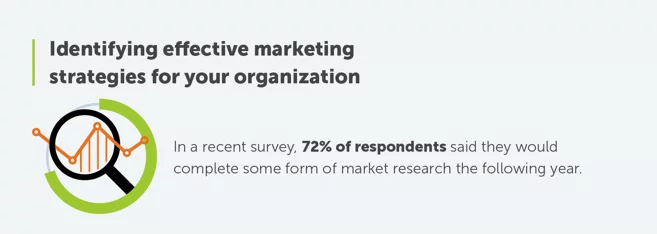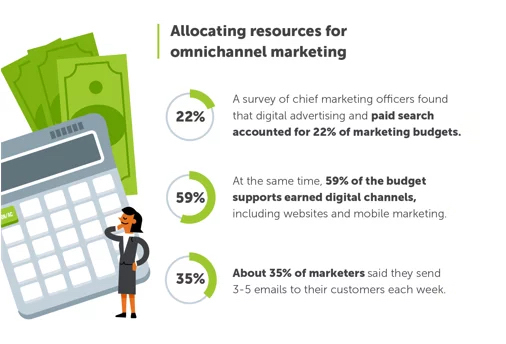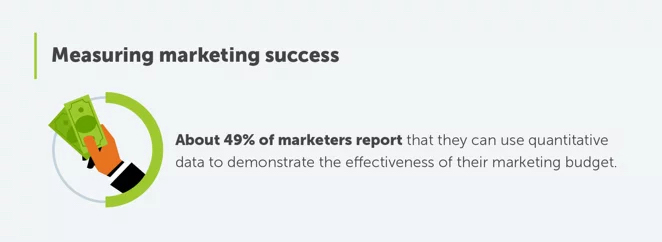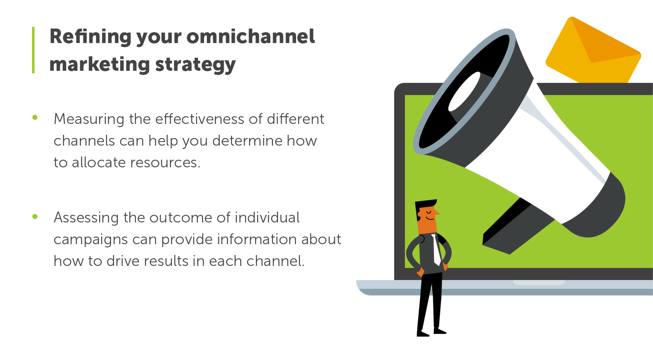Attention is a priceless commodity in today’s connected world. As such, companies have adapted their marketing to new platforms and ways of communicating, rapidly changing the way they interact with prospects and customers.
Financial institutions (FIs) are no exception. These organizations have changed the way they perform their services, from customer and member outreach to self-service and automation. This includes the way services are marketed and which channels are used.
Here are some of the ways omnichannel marketing can be used to promote your financial institution across multiple platforms.
Marketing for financial institutions
Marketing is no longer a basic advertisement pasted in a magazine or on a billboard. Omnichannel marketing requires FIs to be agile, carrying customer and member interactions across several different platforms. Customers now have a direct line of communication to a company or brand. It’s no different for FIs.
Understanding the needs of the customer can be simple when your company is delivering a tangible product, but it’s more complicated when you provide a service like a financial institution. While all marketing initiatives must begin with quality products, the FI is also selling consumers on quality service and the benefits that are derived from it.
Discussions around messaging and tone should be prioritized. What is it about your service that you’d like your prospective and current customers or members to know? How would you like to be perceived when communicating your message? What’s the best way to raise awareness for your FI?
For FIs, the goal should be to appear professional yet approachable through each channel. You want prospective customers or members to get the sense that your organization is reliable yet intuitive – that banking with your FI would be a smooth, enjoyable and secure experience.
Assess what it is about your organization’s service that’s unique compared to other FIs, and use that to inform your marketing strategy. People want to know why they should bank with your FI as opposed to somewhere else. Make it easy for them to see the difference.
Omnichannel marketing strategies
that can work for you
There isn’t a right or wrong way to do marketing, so to speak. Every business is unique and certain combinations of marketing strategies could work in Q2 but not Q3.
After you have a good understanding of what your messaging should be and who your audience is, it will be much easier to decide which marketing strategy will work best for your business.

Outbound marketing methods
Outbound marketing is a method of marketing seeking to push your proactive marketing messaging out to prospective customers and members. In other words, outbound marketing is the more traditional form of marketing and advertising you’re familiar with. Think billboards, magazine page spreads or posters on the sides of buses. This can also include activities such as trade shows, seminar series and cold calling.
Online-based outbound marketing translates to banner ads, pop-ups, auto-playing videos – the type of advertising common on social media and publication sites. Though they can be a useful component of your marketing strategy, it’s possible to overwhelm the viewer with these sorts of ads. They work best when they’re subtle, yet eye-catching. Overly intrusive or irrelevant ads can actually turn people off to your message and potentially your FI as a whole.
What works for financial institutions
To understand what marketing strategy may work best for your organization, think about the products and services you offer and how you could best get your message across.
For community-based FIs, the key to effective marketing is pairing a combination of targeted, narrow-cast print marketing with outbound digital marketing. The goal is to create multiple levels of exposure to the same audience of potential customers and members utilizing different platforms. For FIs implementing a growth strategy, the data consistently shows this provides the greatest opportunity for growth across all generations, particularly in the 25 to 44-year-old demographic.
Imagine someone is moving so they’re looking into changing FIs. In their research, they hear through word of mouth how valuable your products and services are and how friendly your staff is. They may also come across advertisements in their mailbox or in public spaces – all pointing them toward your FI.
By packaging together several different marketing tactics through multiple channels, you can increase your odds of gaining their attention and staying top of mind, so when they do decide to switch, you are first on their list!
How to determine resource allocation for your various marketing channels
Understanding where you should allocate your resources depends on which channel is most effective for getting your message across and creating leads or conversions. For nurturing current customers or members, social media can be a useful tool, building a sense of community around your FI. For growing new customers or members, pairing digital marketing with narrow-cast, targeted print marketing requires more planning, but is a highly effective marketing strategy when used in tandem.

Social media
An FI delivers a service, not a tangible product, which should already tell you more visual social media platforms may not be the best focus for marketing your business, though you should have a presence there regardless.
Each social media platform allows you to create a different rapport with your current customers or members. Creating rapport allows you to make a more effective social media marketing campaign.
Twitter is great for creating a dialogue that’s approachable and encourages people to interact with your FI. You can field questions about the services you offer or give support if someone runs into a problem.
Facebook allows you to be more visual with your posts and answer questions in the comment section. Facebook and Instagram can easily be connected so you can share a post on both platforms at the same time. For community FIs, the value of social media comes with its ability to more fully connect you to your current customers or members and help you provide examples of your dedication to them and your community.
There are several other platforms you can also explore, including LinkedIn, depending on your needs. Whichever platforms your FI chooses to focus on, make sure communication is consistent across all of your channels.
Measuring success: Conversions and attribution
Now that you have an idea of what channels are available to you for marketing your FI, how will you track their returns after you implement them? Tracking return on your marketing and promotion investments needs to be the result of measuring actual results.
With your social media initiatives, how many people entered into the conversation? What kind of dialogue were you able to create? The goal is to utilize social media as a vehicle to move your FI forward as a community contributor and a vigilant supporter of your existing customers or members.
If the goal of your narrow-cast, targeted print and digital marketing initiatives is to grow your core customer or member base, evaluating the overall growth in year-over-year performance should be the overlying metric. How did the FI do? How did individual branches or your online branch perform? In addition, what is the relational intensity of these new customers or members, essentially how many additional products and services are they utilizing? With your digital initiatives, the goal is to determine how many individuals visited your landing pages and how they interacted with those pages. What was the click-through rate? Tracking actual digital conversions is often challenging; however, looking at accounts opened online that received a print invitation as well as a digital impression can be helpful in measuring effectiveness.

Consistently evaluate your audience and refine resource allocation in Omnichannel marketing strategies
Use Data Analytics, such as your customer data and convenience pattern analysis, through AI and Machine learning to evaluate your audience targets. Once you’ve done the work of measuring returns across multiple channels, it may be time to consider modifying your budget to emphasize the ones that are most effective for your FI.
If you’ve made a notable amount of conversions from narrow-cast, targeted print media, consider upping the investment in postcards or self-mailers. Essentially, continue to look for ways to create new relationships and build on existing ones.
As an FI, you provide an important service in your customers’ and members’ lives. Offering exceptional service is the key to deepening relationships following the conversion stage.

Want to learn more about how omnichannel marketing can help your FI? Reach out to us today and get ready to accelerate your growth!